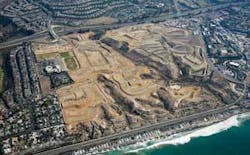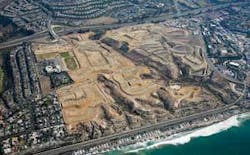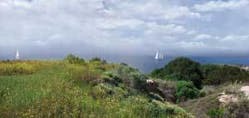By Rebecca Kinney and Anna Lantin
The Marblehead Coastal community in San Clemente is one of the last remaining oceanfront community properties along the Southern California coastline. Located on a coastal plateau, the 248-acre site once comprised agricultural land, an abandoned sewer treatment plant, eroding coastal bluffs, degraded coastal sage habitat and fresh water wetlands. With its prime location adjacent to North Beach, expansive ocean views, rolling topography and a unique site, Marblehead Coastal is a sustainable community planned for 313 high-end residences, a 52-acre regional commercial center, including a luxury outlet mall, a multiscreen movie theater, dozens of restaurants, a hotel and conference center, and over 125 acres of open space.
This community project was planned incorporating sustainable design components, and is designed to meet present needs without compromising those of future generations. The sustainable design minimized short- and long-term environmental impacts of the Marblehead Coastal development activity through resource conservation, recycling, waste minimization and the utilization of energy efficient and ecologically responsible materials and techniques during construction and for longer-term maintenance. In addition, the treatment, infiltration and attenuation of runoff, provided by the site’s preserved natural drain ways, will remain substantially intact.
Many of the sustainable elements of the project were developed as part of the regulatory process in conjunction with the California Regional Water Quality Control Board (CRWQCB), the City of San Clemente, resources agencies, and the California Coastal Commission. This unique process led to the overall stormwater management plan, which includes both peak reduction and water quality Best Management Practices (BMPs). The key concern addressed by the plan was the elimination of dry weather flows (traditionally between April 15 and October 15) to North Beach.
To accomplish the diversion of dry weather flows and treatment of stormwater runoff, the Marblehead Coastal community BMPs incorporate site design, source control and treatment control for water quality treatment, and stormwater management. Both structural and non-structural BMP technologies are utilized throughout Marblehead Coastal public and private parks, streets, commercial properties and residences, including:
- Dry weather diversion systems
- Underground storage vaults
- Vegetated bioswales
- Drain inlet filters
- Wet/extended detention ponds
- Continuous Deflective Separators (CDS®)
- Integrated pest management program
- Regular maintenance education
The project features several primary BMPs: 1) public education; 2) common area maintenance practices; 3) catch basin inserts; 4) CDS units, 5) three water quality extended detention basins; 6) two underground urban runoff storage vaults; and 7) the use of bioswales and natural drainages. Public education and common area maintenance practices are used as a method for preventing stormwater pollution at the source (non-structural BMPs), while catch basin inserts, water quality basins, underground urban runoff storage tanks and CDS units are structural or treatment BMPs.
One of the more effective BMPs is public education. A comprehensive education program will inform the Marblehead Coastal Homeowners Association, their agents and individuals about steps that can be taken to reduce stormwater waste. Maintenance of common areas within residential zones will utilize efficient irrigation systems, as well as integrated pest and vegetative management, to control pests and vegetation. These policies use chemical control as a “last resort,” substituting instead manual vegetation control and natural processes for control of pests.
The Marblehead Coastal treatment BMP program consists of five distinct treatment devices: 1) catch basin inserts, including trash racks, bars or grated inlet covers, and covered trash receptors; 2) extended detention basins and underground storage vaults; 3) dry weather diversion systems; 4) bioswales; and 5) CDS units. Portions of the commercial center storm flows are also either captured or treated by an extended detention basin, diversion, or in a bioswale.
Catch Basin Inserts
Catch basin inserts comprise a flexible storm drain catchment and filtration liner designed to collect contaminants and debris prior to discharge into the storm drain. The filtration liner traps suspended solids in a basket and captures some free petroleum hydrocarbons. Catch basins within Marblehead Coastal streets are fitted with catch basin inserts, which treat the maximum flow rate of runoff produced from a rainfall intensity of 0.2 inch of rainfall per hour (85th percentile) in accordance with the San Diego Regional Water Quality Control Board requirements. The catch basin inserts treat all storm flows from developed areas. The catch basin inserts span 70% of the curb opening for the catch basin.
Extended Detention Basins
One of the key stormwater and water quality design features of the Marblehead Coastal project is the capture and treatment of the peak stormwater runoff before it flows to the Pacific Ocean. The water reclamation system at Marblehead is very comprehensive and advanced. There are three extended detention basins within Marblehead Coastal open space.
Residential stormwater flows drain into both private and public storm drain pipe systems that then enter into the settlement and biofiltration extended detention basins (which also include a traditional detention basin component) within the Marblehead Coastal Development project. There are three of the combined extended/traditional detention basins located within the habitat management areas. Additionally, stormwater flows from the commercial development are intercepted by the underground storm drain system and directed to the detention basins when the capacity of the capture and diversion system in the commercial area is exceeded. The addition of the traditional detention basins to the project mitigates increased water flows by detaining flows to reduce peaks to less than existing conditions or less than existing downstream capacity, whichever is less.
The extended detention portions of the basin (i.e., the lower portions of the basin) are constructed wetlands and differ from natural wetlands primarily in having a greater average depth. The bottom 36 inches of the constructed extended water basin is a subsurface wetland with rock, sand and vegetation. The extended basins treat incoming stormwater runoff by settling and biological uptake. Heavier coarse material, such as trash or metals settle out and are trapped in the basins’ forebay areas. The smaller particulate sediment that remains is easily removed through regular maintenance operations. Waste uptake, particularly of nutrients, also occurs through biological activity in the extended detention basin pond. During the dry season, the extended detention basins function as subsurface retention basins for overflow water from urban activities.
Extended detention basins provide the following waste removal mechanisms: settling or sedimentation; adsorption to sediments, vegetation, or detritus; filtration by plants; microbial uptake and/or transformations; and uptake by wetland plants or algae. The removal of urban runoff waste occurs during the slow draining of the basin (minimum of 40 hours).
The draining of the extended basin is accomplished by constructing a perforated riser or small concrete outlet structure surrounded by a debris screen. The 36 inches beneath the floor of the extended detention basin is composed of sand and gravel, which capture dry weather and low flows to sustain the wetlands. Once the water passes through the basin, it returns back into the storm drain system and is delivered to El Camino Real where dry weather flows will be diverted to an existing sewer line and sent to the City of San Celemente Water Reclamation Plant for further treatment prior to discharge through the offshore wastewater outfall.
Diversion Systems
Diversion of first flush and dry weather flows is included in the Marblehead Coastal project. On the commercial site, both first flush and dry weather flows are diverted to two underground detention vaults using the STORMTrap™. After flows leave the detention basins, they are directed to CDS units that act as dry weather diverters along El Camino Real. The diversions send flows to the sewer system, then ultimately for treatment at the City’s treatment plant. City staff operate each diversion remotely in order to provide operational flexibility.
Bioswales
Bioswales and biostrips, also known as vegetated swales, perform an integral role in the Marblehead Coastal Water Quality Program. Bioswales are a combination of grasslands and a wide, gently sloping channel (5’-7’ base width with 4:1 or flatter side slopes) designed to filter a shallow depth of untreated stormwater runoff.
Untreated stormwater runoff is intercepted from roadway gutters, parking lots or other hard, impervious paved surfaces before it enters a catch basin and is directed through a vegetated swale. The stormwater slowly travels the length of the bioswale through the vegetation, which filters out sediment and particulate matter. The slower moving water also infiltrates the soil channel, which removes additional waste and reduces water runoff volumes. The particulates and waste are degraded and broken down by biological activity. Following filtration, the treated stormwater runoff enters the storm drain system.
Bioswales and biostrips are important for water quality, as untreated stormwater runoff from streets usually enters catch basins and the storm drain piping system, emptying waste directly into the Pacific Ocean. Vegetated swales cleanse the stormwater runoff, removing trash and other pollutants before the water drains into the ocean.
Bioswales vegetated with native grasslands not only improve water quality but also provide habitat and aesthetic benefits. The Marblehead Coastal Water Quality Program contains three bioswales: one at the Sports Park, one at Pico Park, and one adjacent to Avenida Pico. A biostrip is also located in Pico Park.
CDS Units
The final segment of the water quality treatment train is the end-of-pipe controls. For Marblehead Coastal, the end-of-pipe controls consist of CDS units. Although the use of CDS units at the end of a treatment train is not common, in the Marblehead Program the units act as dry weather flow diversions to the sewer system, which will then be treated at the city’s treatment plant. The use of CDS units prior to the diversion assures the city that large solids will not enter the sewer system. The five CDS units are a non-blocking, non-mechanical screening system, which will provide a final line of defense for solids removal. Adsorption material can be added within the units to aid in the removal of oil and grease. The treated flow exits the units and continues downstream.
The Marblehead Coastal stormwater quality plan is a key component of the overall sustainable design. In order to ensure its success, the Marblehead Stormwater Quality Monitoring Plan was created. It includes baseline water quality testing and post-construction water quality testing to assess the effectiveness of the system in meeting water quality objectives. Should data demonstrate that the BMPs are not adequately addressing the objectives, the overall stormwater quality plan will be re-evaluated. The continual re-evaluation of the system will help meet the overall project’s sustainable design objectives.
About the Authors:
Rebecca Kinney, P.E., RBF Consulting, has extensive experience in all phases of stormwater management projects including planning, design and construction. Her recent experience has focused on development of Master Plans of Drainage, which focus on storm drainage facility sizing, stormwater NPDES compliance, stream stability, and floodplain management. Anna Lantin, P.E., C.P.S.W.Q., C.P.E.S.C., RBF Consulting, has extensive experience in stormwater management projects in the state including stormwater quality research studies, Best Management Practices (BMP) design, construction oversight, BMP implementation, water quality monitoring, operation and maintenance, and performance data analysis.







